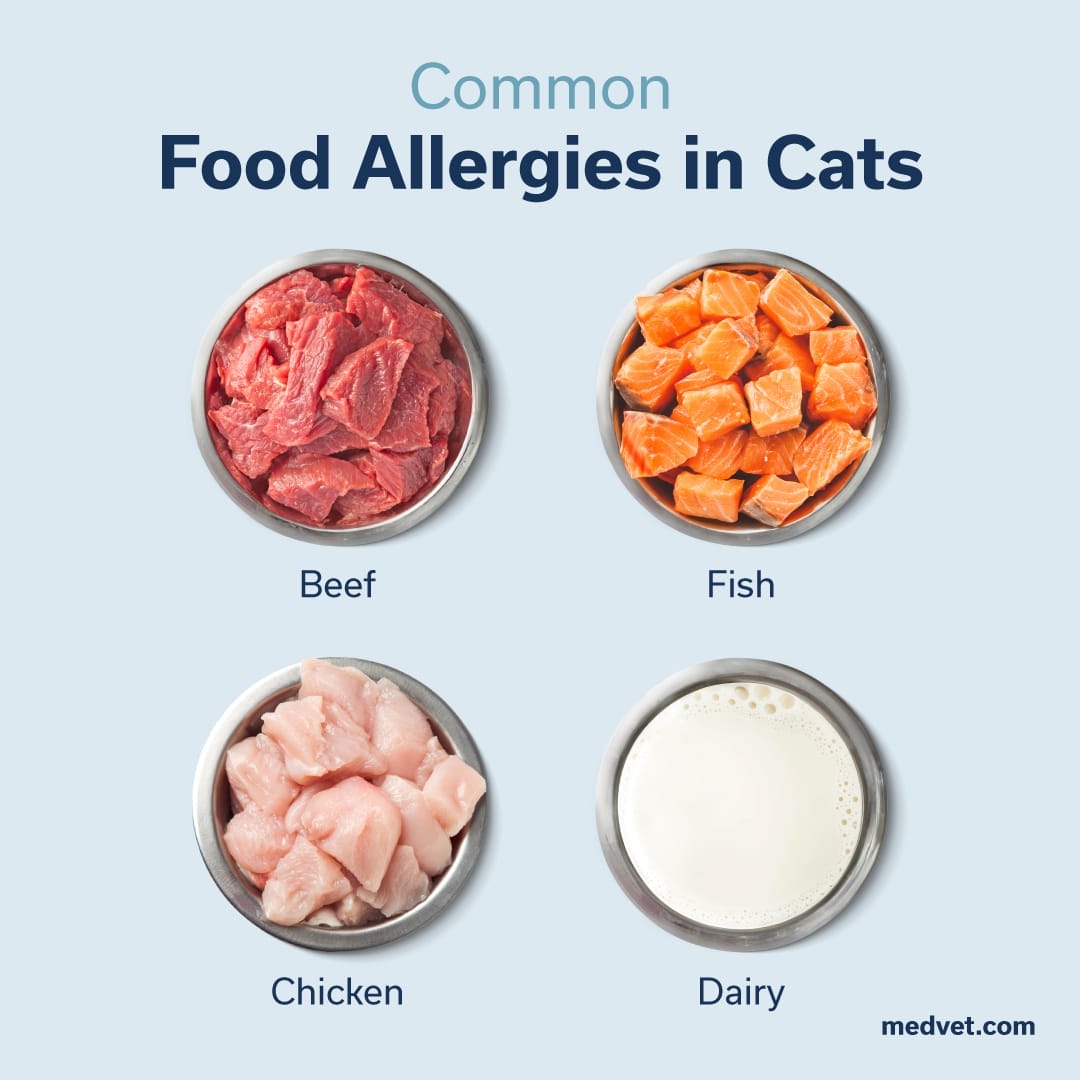
When a cat’s immune system repeatedly reacts adversely to a selected ingredient of their meals, they’ve developed a meals allergy. However how do which ingredient is inflicting your cat’s allergic response and what are you able to do about it? Learn on to be taught extra about meals allergy symptoms in cats, the indicators your cat could also be allergic to their meals, how veterinary dermatologists diagnose meals allergy symptoms, and what you may do to administer your cat’s meals allergy symptoms.
What Causes Meals Allergy symptoms in Cats?
Meals allergy symptoms in cats, additionally often known as cutaneous adversarial meals response (CAFR), are amongst probably the most frequent allergy symptoms felines expertise. It happens when your cat’s immune system overreacts and produces antibodies to a protein or complicated carbohydrate of their meals, inflicting irritation of their physique. As a result of it takes time to your cat’s physique to develop antibodies to an ingredient, they will develop allergy symptoms to meals they’ve been consuming for a very long time.
Whereas the precise reason for meals allergy symptoms continues to be unknown, it’s believed to be a mix of genetic predisposition and publicity to particular allergens.
Frequent Meals Allergy symptoms in Cats and Indicators
Though cats can develop allergy symptoms to any protein or carbohydrate they’ve been uncovered to, probably the most frequent meals allergy symptoms for cats are beef, fish, rooster, and dairy merchandise.
Much less generally, they will have allergic reactions to wheat, corn, dairy, lamb, egg, barley, and rabbit.
Essentially the most frequent signal of meals allergy symptoms in cats is continual itching, pores and skin lesions, and lack of hair. The itching usually impacts areas corresponding to the face, ears, stomach, groin, armpits, legs, and paws.
As a result of it takes time for a cat’s immune system to construct antibodies towards sure proteins or carbohydrates, the indicators your cat is experiencing an allergic response can even take time and probably intensify.
Along with continual itching and pores and skin irritation, some cats may develop recurrent pores and skin and ear infections. Gastrointestinal indicators, like vomiting, diarrhea, and scooting may be current in some circumstances. Moreover, some cats might develop inflammatory bowel illness.

How Do You Know if Your Cat Has Meals Allergy symptoms?
Essentially the most dependable methodology for diagnosing meals allergy (CAFR) in cats is an elimination food regimen trial, which includes feeding a food regimen that doesn’t include any proteins your cat has been beforehand uncovered to. This trial can take a minimum of eight weeks and needs to be supervised by a veterinarian. In the course of the trial, it’s essential to eradicate all different treats, dietary supplements, and edible merchandise to make sure correct outcomes.
Take a look at diets are both a “novel” protein food regimen (no earlier publicity to that protein) or hydrolyzed protein (protein that has been modified in order that it shouldn’t be allergenic). Manufacturing, dealing with, and packaging of the food regimen can also be vital. There are usually not many over-the-counter diets that meet the factors for an applicable meals trial. There are dry and canned prescription diets out there for meals allergy sufferers. Residence cooking may be wanted in some circumstances.
Whereas there are blood, saliva, and hair “checks” commercially out there to “diagnose” meals allergy in pets, they are usually not really useful as they are usually not correct or dependable.
What Occurs Throughout a Meals Trial for Cats
Your veterinarian or veterinary dermatologist will information you on how one can efficiently administer a meals trial to your cat. Solely feed your cat the prescribed food regimen and water and be certain that month-to-month preventatives, like heartworm and ectoparasite preventatives, are usually not flavored.
Listed here are a number of ideas when beginning a meals trial:
- Completely clear all meals bowls with cleaning soap and water earlier than starting the brand new food regimen.
- Guarantee all household pets are separated at feeding time. Choose up bowls after feeding. Don’t allow the pet on the trial to lick or eat from one other pet’s bowl. If that happens, the trial have to be restarted. You might need to think about transitioning all family pets to the trial food regimen. If totally different diets are fed, present separate meals and water bowls.
- Introduce the trial food regimen regularly over three to seven days to stop abdomen upset. Do that by mixing equal portions of your cat’s authentic food regimen with the brand new food regimen, regularly withdrawing the authentic food regimen. Save one to 2 weeks of the authentic food regimen for rechallenge later if wanted.
- Droop use of treats and some other potential allergen sources. Heartworm and ectoparasite (flea) preventatives have to be topical or nonflavored.
- Don’t give medicines to your pet in any meals or tablet pockets. Ask your veterinary dermatologist earlier than giving any dietary supplements or medicines through the meals trial.
Diagnostic meals trials are usually eight weeks in period. The immune system typically takes 4 weeks to alter to the brand new food regimen and as much as eight weeks to see an enchancment or discount of your cat’s scientific indicators.

Treating Meals Allergy symptoms in Cats
Reckoning on the interpretation of the diagnostic meals trial, your veterinarian might prescribe a retrial. The preliminary problem is finished with the authentic food regimen. If CAFR is confirmed, you could elect to return and feed the prescribed food regimen to your cat’s life.
There are occasions when your veterinary dermatologist might suggest a rechallenge, corresponding to if there’s a have to determine the particular offending allergen. Throughout this course of, your pet stays on the trial food regimen whereas single elements are launched one by one. Every launched allergen is fed for 10-14 days to watch for a flare in indicators.
The reintroductions may embrace meats (rooster, turkey, beef, pork, white fish, salmon, lamb, and so on.), grains and carbohydrates (rice, oat, wheat, and so on.), dairy (milk, cheese), and egg.
As soon as your cat’s allergen is recognized, it’s vital to keep away from all treats, dietary supplements, and meals that include the allergen. Retail pet meals labeled as “limited-ingredient” is probably not appropriate for cats with meals allergy symptoms on account of the danger of cross-contamination.
Common follow-ups along with your veterinarian are obligatory to watch your cat’s progress and make any obligatory changes to their food regimen.

